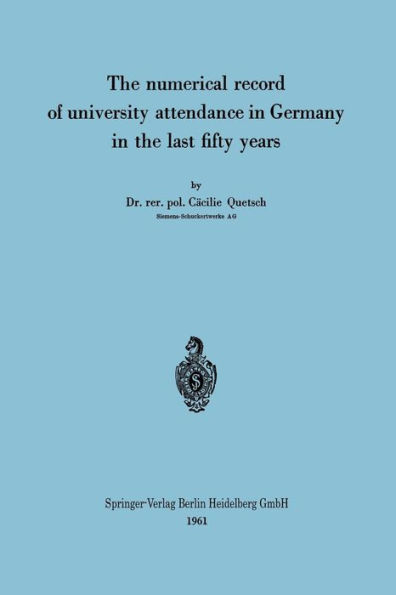The numerical record of university attendance in Germany in the last fifty years
The question "Does the total number of students and their enrollment in different faculties meet present-day requirements" evokes keen dis- cussion among the responsible authorities and the public today. The present stage of these discussions and the data available, however, make it difficult to obtain a clear idea of the actual developments in this respect. The reason for this is not merely that the interests of the groups concerned frequently conflict and that certain single facts are, therefore, seized upon "as required" to prove a point, but mainly because the difficulty lies in forming a clear picture of the interrelation of the factors involved. The present study therefore aims at depicting the development of university attendance statistically and to take such information as a basis for ascertaining, describing and, where possible, quantitatively analysing the most important influences in order to finally discuss whether the anticipated development can be evaluated in the light of the knowledge thereby gained. Basic trends in sociological processes can be more readily discemed if sufficiently large groups are considered and their development traced over as long aperiod as possible. This thought has prompted the inclusion of only the following groups of faculties for study, without further subdivisions: Engineering (civii engineering, mechanical engineering, including ship- building, electrical engineering, mining and metallurgy, but excluding architecture and geodesy). Natural Science (mathematics, physics, astronomy, geophysics, mete- orology, chemistry, biology, zoology, geography, geology, mineralogy, among others). Law. Economics (political economy, business administration, political science).
1117664335
The numerical record of university attendance in Germany in the last fifty years
The question "Does the total number of students and their enrollment in different faculties meet present-day requirements" evokes keen dis- cussion among the responsible authorities and the public today. The present stage of these discussions and the data available, however, make it difficult to obtain a clear idea of the actual developments in this respect. The reason for this is not merely that the interests of the groups concerned frequently conflict and that certain single facts are, therefore, seized upon "as required" to prove a point, but mainly because the difficulty lies in forming a clear picture of the interrelation of the factors involved. The present study therefore aims at depicting the development of university attendance statistically and to take such information as a basis for ascertaining, describing and, where possible, quantitatively analysing the most important influences in order to finally discuss whether the anticipated development can be evaluated in the light of the knowledge thereby gained. Basic trends in sociological processes can be more readily discemed if sufficiently large groups are considered and their development traced over as long aperiod as possible. This thought has prompted the inclusion of only the following groups of faculties for study, without further subdivisions: Engineering (civii engineering, mechanical engineering, including ship- building, electrical engineering, mining and metallurgy, but excluding architecture and geodesy). Natural Science (mathematics, physics, astronomy, geophysics, mete- orology, chemistry, biology, zoology, geography, geology, mineralogy, among others). Law. Economics (political economy, business administration, political science).
59.99
In Stock
5
1

The numerical record of university attendance in Germany in the last fifty years
56
The numerical record of university attendance in Germany in the last fifty years
56Paperback(1961)
$59.99
59.99
In Stock

Product Details
| ISBN-13: | 9783662281642 |
|---|---|
| Publisher: | Springer Berlin Heidelberg |
| Publication date: | 01/01/1961 |
| Edition description: | 1961 |
| Pages: | 56 |
| Product dimensions: | 6.10(w) x 9.25(h) x 0.01(d) |
| Language: | German |
From the B&N Reads Blog
